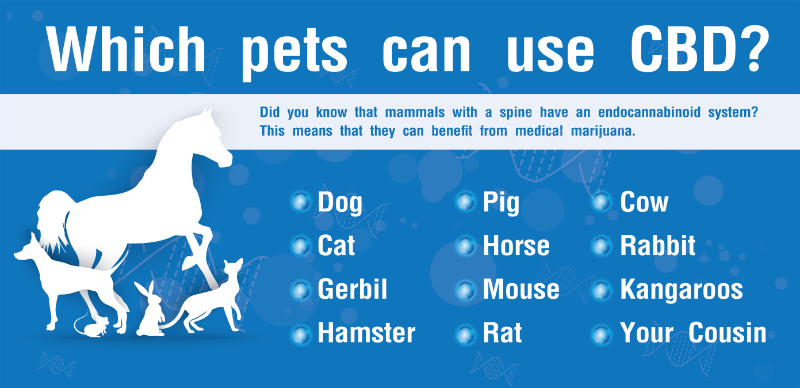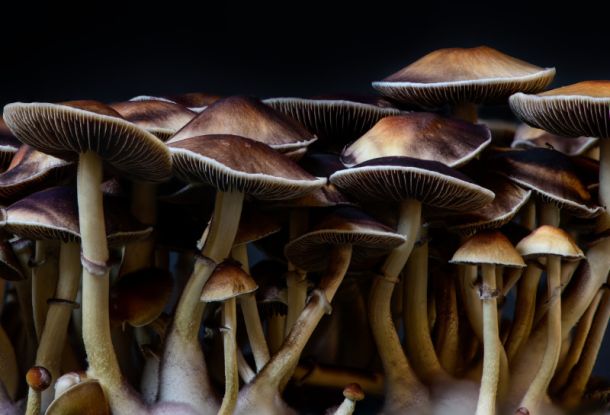Can I Give CBD to my Pet?
Animals and humans have a lot more in common than one may think. Like humans, many animals share most of the same organs and systems. One of the most important of these system’s being: The Endocannabinoid system.
What is the Endocannabinoid System?
Inside of your pets bodies (and ours too), there is a complex cell-signalling system called the Endocannabinoid system, ECS. This system involves three things…
Endocannabinoid Receptor cells are located throughout the bodies of many animals. There are two different types of receptor cells: CB1 Receptors (found in the central nervous system, spinal cord and brain) and CB2 Receptors (found in peripheral nervous system, commonly known as the immune system). These receptors are responsible for receiving endocannabinoids and responding by sending signals from the brain to the rest of the body.
Endocannabinoids are molecules naturally created throughout our pet’s bodies in response to unhealthy cells. These Endocannabinoids attach to and activate specific receptors that target the problem detected in the body. For example, Endocannabinoids might target CB1 receptors in a spinal nerve to relieve pain. Others might bind to a CB2 receptor in your immune cells to signal that your body’s experiencing inflammation, a common sign of autoimmune disorders.
Enzymes are responsible for breaking endocannabinoids down once they have carried out their function.
This messenger system plays a role in creating homeostasis (the stability of the internal environment) in many areas of our pet’s bodies…
-
Appetite
-
Digestion
-
Body Temperature
-
Motor Control
-
Reproduction System
-
Pain
-
Memory
-
Immune Function
-
Cognitive Function
-
Sleep
-
Fertility
Our pets bodies know when one of these areas are out of balance and make endocannabinoids specific for the receptors associated with the area that is in need of homeostasis. Once this part of the body has achieved balance, enzymes will then work to break down the endocannabinoid molecules that have conducted their job. This is a continuous process that happens in their body everyday to keep the body in a healthy state.
Sometimes the ECS doesn’t work properly and leaves our beloved pets feeling uncomfortable and unbalanced. To us pet owners this may look like:
-
Vomiting
-
Diarrhea
-
Constipation
-
Lack of Apetite
-
Aggression/Short Temper
-
Lethargic/Always Tired
-
Melancholy/Always Tired
-
Whimpering/Pain
-
Excessive/Unusual Panting
-
Fearful Behaviour
According to researchers, the cause of many chronic conditions may be due to Clinical Endocannabinoid Deficiency Syndrome –– the lack of endocannabinoids. When our furry family members end up with these health imbalances, we take them to the vet and often they are prescribed pharmaceuticals. Many of these pharmaceuticals improve your pet’s symptoms but can also deliver some uncomfortable side effects. This is when many pet owners will turn to natural remedies like CBD.
“So what exactly does CBD do in our pet’s body?”
The Cannabis plant contains 144 different Cannabinoids. Yes, there’s that word again… The cannabinoids that come from a plant are called Phytocannabinoids and the cannabinoids that our bodies make are called Endocannabinoids. It turns out that our bodies recognize Phytocannabinoids and respond in similar ways as they do to Endocannabinoids.
CBD is one of the Phytocannabinoids that comes from the Cannabis plant. No, this molecule will not get your pet “high.” It is actually one of the MANY Phytocannabinoids within the cannabis plant that does not cause psychoactive affects.
When your pet ingests CBD, the phytocannabinoid acts as an endocannabinoid and attaches to the same receptors in your pets body which then triggers a response from the endocannabinoid system. The triggered response allows the endocannabinoid system to identify the imbalances in the body and create the endocannabinoids needed to achieve homeostasis, or balance. CBD is essentially the boost your pet’s endocannabinoid system needs to perform adequately.
Influencing the Endocannabinoid system allows us to target:
-
Pain Management
-
Cancer Therapeutics
-
Modulation of Neurological Disorders
-
Stress Reduction
-
Anxiety Management
-
Inflammatory Diseases (IBS, Arthritis, Allergies, Skin Irritations)
-
Glaucoma
-
Seizures
And maintain everyday health:
-
Healthy Fur Coat and Skin
-
Relief from Skin Irritations and Allergies
-
Joint and Mobility Health
-
Quality of Life
MANY animals have an Endocannabinoid system?! This enables many of us pet owners to reap the benefits of CBD for our pets. Some of these animals include:

How do I use CBD for my pet?
Here at TLC we infuse CBD Isolate (guaranteed no THC) into an organic MCT Oil (coconut) to create an easy to administer, all-natural liquid based CBD for your pet. Our CBD product is made for dogs or cats although we do take requests for appropriate strengths made for diverse types of animals, please contact.
This CBD Oil is given orally to your pet, in the dosage recommended on the bottle. You can administer the dose directly into their mouth or applied with food. There is little to no taste, making this a hassle-free experience!
What is the suggested CBD dose for my pet?
Finding the right CBD oil dosage for your pet takes time and a lot of patience, especially for pets in poor health. A good rule of thumb regarding CBD oil administration for animals is “less is more”.
| Pet Weight | Low Dose | Medium Dose | Strong Dose |
|---|---|---|---|
| About 5 Pounds | .5mg | 1.5mg | 2.5mg |
| About 10 Pounds | 1mg | 3mg | 5mg |
| About 20 Pounds | 2mg | 6mg | 10mg |
| About 30 Pounds | 3mg | 8mg | 15mg |
| About 40 Pounds | 4mg | 10mg | 20mg |
| About 50 Pounds | 5mg | 12mg | 25mg |
| About 60 Pounds | 6mg | 14mg | 30mg |
| About 70 Pounds | 7mg | 16mg | 35mg |
| About 80 Pounds | 8mg | 18mg | 40mg |
| About 90 Pounds | 9mg | 20mg | 45mg |
| About 100 Pounds | 10mg | 22mg | 50mg |
Tips for Giving CBD to Your Pet:
- Start with a low dose.
- Monitor your pet’s reactions.
- Increase doses slowly if needed.
- Can be administered once or twice daily according to your pet’s weight.
Please Note: If your pet has a history of health issues, it’s important to consult with your veterinarian before administering CBD oil. They may suggest a lower or higher dose depending on their health, and they may want to monitor them especially if they are taking other medications. Nevertheless, when considering the appropriate amount of CBD oil, it’s important to administer gradually. Start CBD oil slowly, administering a small amount at a time. Then incrementally increase the amount until you see improvements.



